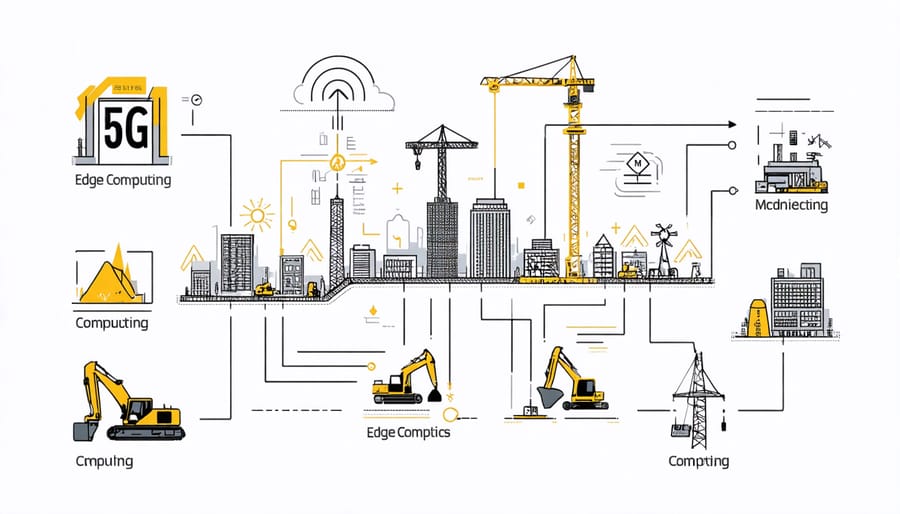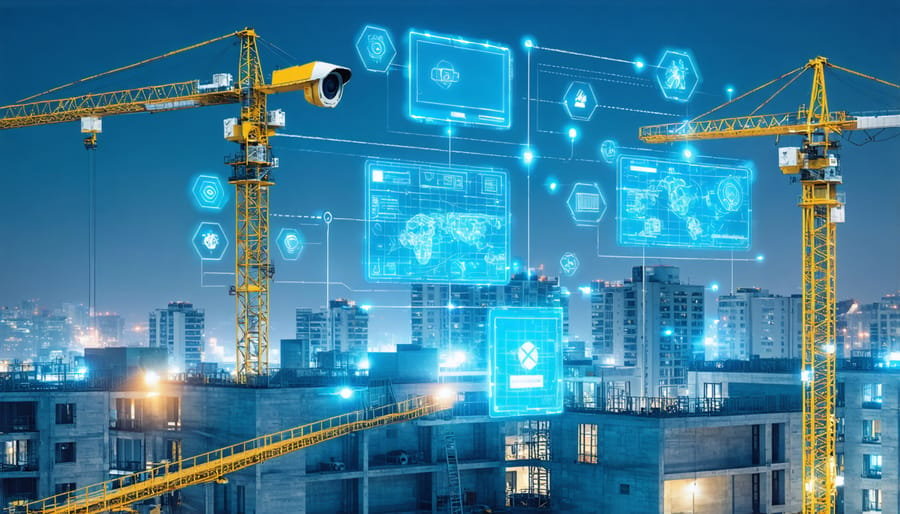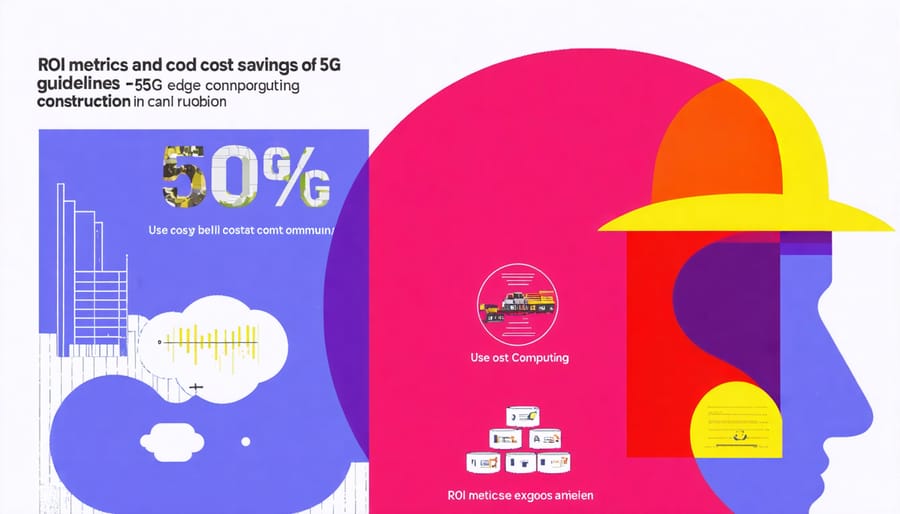The convergence of 5G networks and edge computing is revolutionizing construction site operations, enabling real-time decision-making and unprecedented levels of automation. By processing data closer to its source, construction firms can now analyze massive streams of IoT sensor data, coordinate autonomous equipment, and manage safety systems with near-zero latency. This technological fusion delivers the robust connectivity and computing power needed for next-generation construction applications – from AI-powered quality control to augmented reality project visualization.
Recent implementations at major infrastructure projects demonstrate that 5G edge computing reduces data transmission costs by up to 70% while improving response times from 100+ milliseconds to under 10 milliseconds. For construction leaders, this translates to enhanced worker safety, optimized resource allocation, and significantly improved project delivery timelines. The ability to process and act on data instantly, even in remote locations, is transforming how construction sites operate, monitor progress, and maintain compliance with evolving safety standards.
This practical guide explores how construction firms can leverage 5G edge computing to achieve operational excellence, examining real-world applications, implementation strategies, and measurable ROI metrics specific to the construction industry.
The Power of 5G Edge Computing in Construction

Real-Time Data Processing at the Edge
Real-time data processing at the edge fundamentally transforms how construction sites handle critical information by bringing computing power closer to where data is generated. Instead of sending vast amounts of data from IoT sensors, equipment monitors, and safety systems to distant cloud servers, edge computing enables instant processing right at the construction site.
This localized processing dramatically reduces latency from seconds to milliseconds, enabling immediate responses to critical situations. For example, when safety sensors detect potential hazards, edge computing can trigger instant alerts or equipment shutdowns without the delay of cloud communication. Similarly, real-time analysis of concrete curing data allows for immediate adjustments to environmental controls, ensuring optimal conditions.
The combination of 5G’s high-speed connectivity and edge computing creates a powerful infrastructure for processing massive amounts of jobsite data. Construction managers can monitor structural integrity, track equipment performance, and analyze worker safety patterns with near-zero delay. This capability is particularly valuable for applications like crane operations, where split-second decisions based on wind conditions and load calculations can prevent accidents and improve efficiency.
5G Network Integration
The integration of 5G networks with edge computing creates a powerful synergy that revolutionizes construction site operations. By leveraging 5G’s ultra-low latency and high bandwidth capabilities, construction teams can process massive amounts of data directly at the edge, enabling real-time decision-making and enhanced site monitoring.
5G’s network slicing technology allows construction companies to create dedicated virtual networks for different applications, ensuring critical operations receive prioritized bandwidth and resources. This means drone surveillance, equipment monitoring, and safety systems can operate simultaneously without competing for network resources.
The enhanced mobile broadband (eMBB) feature of 5G supports high-definition video streaming and augmented reality applications, while massive machine-type communications (mMTC) enables thousands of IoT devices to connect simultaneously. This combination supports comprehensive site monitoring, from worker safety tracking to equipment performance analysis.
With 5G’s reliability and speed, edge computing nodes can process data from multiple sources with minimal latency, typically under 10 milliseconds. This enables real-time responses to safety incidents, equipment malfunctions, and workflow bottlenecks, significantly improving site efficiency and worker safety.
Key Applications in Construction
BIM and Digital Twin Integration
The integration of 5G edge computing with Building Information Modeling (BIM) and digital twin applications represents a significant advancement in construction technology. Through low-latency data processing and high-bandwidth connectivity, 5G edge compute enables real-time updates to BIM models directly from the construction site, ensuring that all stakeholders work with the most current information.
Construction teams can now capture and process vast amounts of sensor data, photogrammetry, and laser scanning information at the edge, updating digital models instantly without the delays associated with cloud processing. This immediate data integration allows for rapid detection of construction discrepancies, enhanced quality control, and more efficient project management.
The system’s capability to handle complex computational tasks on-site facilitates continuous digital twin maintenance, enabling real-time monitoring of building systems, structural health, and construction progress. Project managers can visualize changes, simulate scenarios, and make informed decisions based on accurate, up-to-the-minute data.
Edge computing’s proximity to data sources also enables advanced features like augmented reality overlays for on-site workers, immediate clash detection, and automated compliance checking. This technological synergy significantly reduces the risk of errors, accelerates project timelines, and improves collaboration between different construction disciplines, ultimately delivering more precise and efficient project outcomes.

IoT Sensor Networks
IoT sensor networks are transforming construction site monitoring through 5G edge computing capabilities. These networks enable real-time monitoring of thousands of sensors across large construction sites, providing immediate insights into equipment performance, structural integrity, and environmental conditions.
The combination of 5G and edge computing allows for processing sensor data directly at the construction site, reducing latency and enabling instant decision-making. This is particularly crucial for safety-critical applications such as crane operations, structural load monitoring, and environmental hazard detection.
Construction companies are deploying smart sensors to monitor everything from concrete curing conditions to equipment utilization rates. Edge computing processes this data locally, triggering immediate alerts when measurements exceed predetermined thresholds. This rapid response capability helps prevent equipment failures, optimize maintenance schedules, and ensure compliance with safety regulations.
For example, Turner Construction implemented this technology across their major projects, resulting in a 30% reduction in equipment downtime and significant improvements in predictive maintenance accuracy. The system processes data from over 10,000 sensors per site, with edge computing nodes handling real-time analytics that would otherwise overwhelm traditional cloud infrastructure.
These advanced monitoring capabilities also enable automated reporting and compliance documentation, streamlining regulatory requirements while providing comprehensive operational visibility across multiple construction sites.
Site Safety and Security
5G edge computing revolutionizes site safety and security through advanced real-time monitoring capabilities and AI-powered surveillance systems. By processing data at the edge, construction sites can implement instantaneous threat detection and emergency response protocols without the latency associated with cloud-based solutions.
Smart cameras equipped with edge computing capabilities can analyze video feeds in real-time, identifying potential safety violations, unauthorized access, and hazardous conditions. These systems can automatically alert site supervisors when workers enter restricted areas or fail to wear proper PPE, enabling immediate intervention before accidents occur.
AI-powered fall detection systems leverage 5G’s ultra-low latency to monitor worker movements and instantly notify emergency responders of incidents. Environmental sensors connected to edge computing nodes continuously monitor air quality, temperature, and structural stability, providing early warning of dangerous conditions.
The integration of biometric access control systems with edge computing enables robust site security while maintaining rapid authentication speeds. Workers can be quickly verified and tracked throughout the site, ensuring compliance with safety protocols and maintaining accurate personnel counts during emergencies.
Case studies have shown that construction sites implementing 5G edge computing for safety monitoring have reduced workplace incidents by up to 35% and improved emergency response times by 60%. The system’s ability to process and act on data locally also ensures continued operation during network outages, maintaining site security even in challenging conditions.
Implementation Challenges and Solutions
Infrastructure Requirements
The implementation of 5G edge computing at construction sites requires a robust infrastructure foundation comprising both hardware and network components. At the core, sites need dedicated 5G-enabled small cell base stations strategically positioned to ensure comprehensive coverage across the construction area. These cells must be complemented by edge servers, typically housed in weather-protected enclosures, capable of processing data locally with minimal latency.
Essential hardware components include ruggedized edge computing devices designed to withstand construction site conditions, high-bandwidth routers, and advanced network switches. The infrastructure must also incorporate redundant power supplies and backup systems to maintain continuous operation. Multiple distributed antenna systems (DAS) are often necessary to penetrate through steel structures and concrete, ensuring consistent connectivity throughout the site.
Network infrastructure requirements include dedicated fiber-optic backhaul connections to support high-speed data transmission, software-defined networking (SDN) capabilities for flexible network management, and network slicing functionality to prioritize critical applications. Security infrastructure is paramount, necessitating physical security measures for edge computing equipment and comprehensive cybersecurity protocols including firewalls, encryption systems, and intrusion detection systems.
Integration points must be established between the edge computing infrastructure and existing construction management systems, requiring careful planning of APIs and data exchange protocols. Temperature control systems and environmental monitoring equipment are also essential to maintain optimal operating conditions for the computing hardware in challenging construction environments.
Data Security Considerations
In the rapidly evolving landscape of 5G edge computing, construction data security remains a paramount concern. The distributed nature of edge computing infrastructure introduces unique vulnerabilities that require robust protection measures. Construction sites implementing 5G edge computing must adopt a multi-layered security approach, incorporating encryption protocols, access control systems, and real-time monitoring solutions.
Key security measures include end-to-end data encryption, secure boot mechanisms for edge devices, and regular security audits of all connected systems. Construction firms must implement strong authentication protocols and maintain strict access controls for both on-site and remote workers accessing edge computing resources.
Physical security of edge computing infrastructure is equally crucial. Edge nodes and computing devices must be protected from environmental hazards, tampering, and unauthorized access through proper housing and monitoring systems. Regular security assessments should be conducted to identify potential vulnerabilities and implement necessary countermeasures.
Organizations should also establish clear security policies and procedures, including incident response plans and data backup strategies. Training programs for staff members handling edge computing systems are essential to maintain security awareness and prevent human-related security breaches. Regular updates and patches must be applied to all edge computing components to protect against emerging threats and vulnerabilities.
Future Outlook and ROI Analysis

Cost Benefits Analysis
The implementation of 5G edge computing in construction projects demonstrates significant cost advantages through multiple channels. Initial analysis shows potential cost reductions of 15-25% in overall IT infrastructure expenses, primarily through decreased data transmission and storage costs. By processing data locally, construction firms can reduce cloud computing expenses by up to 30% while maintaining superior performance for critical applications.
Real-world implementations have shown that construction data analysis benefits are amplified through edge computing, with response times improved by 75% and bandwidth costs reduced by 40%. Equipment maintenance costs typically decrease by 20-30% through predictive analytics and real-time monitoring capabilities.
The technology’s ability to support multiple concurrent IoT devices while maintaining low latency translates to operational savings of approximately $2,000-3,000 per month for medium-sized construction sites. Labor efficiency improvements of 12-15% have been documented through enhanced real-time collaboration and automated workflow optimization. When factoring in reduced downtime, improved safety monitoring, and enhanced resource allocation, the total ROI typically materializes within 12-18 months of implementation.
Future Development Roadmap
The integration of 5G edge computing in construction is poised for significant advancement over the next few years. Industry experts anticipate the emergence of enhanced real-time modeling capabilities, allowing for instantaneous design modifications and structural analysis on-site. Advanced IoT sensor networks will enable more sophisticated monitoring of construction equipment, materials, and environmental conditions.
By 2025, we expect to see the widespread adoption of AI-powered edge computing solutions that can process vast amounts of data from multiple sources, including drones, wearables, and autonomous construction equipment. These systems will provide predictive maintenance alerts and real-time safety monitoring with negligible latency.
Future developments will likely include enhanced mixed reality applications, enabling workers to visualize complex installations through high-fidelity 3D models rendered at the edge. The integration of blockchain technology with edge computing will improve supply chain transparency and contract management.
Construction companies should prepare for the convergence of 5G edge computing with emerging technologies like digital twins and autonomous robotics, which will revolutionize project delivery methods and site optimization strategies.
The implementation of 5G edge computing represents a transformative opportunity for construction companies to revolutionize their operations and achieve unprecedented levels of efficiency and innovation. By embracing this technology, construction firms can benefit from real-time data processing, enhanced site safety, improved project coordination, and significant cost savings through optimized resource allocation.
To successfully integrate 5G edge computing into construction operations, companies should begin by conducting a thorough assessment of their current technological infrastructure and identifying specific areas where edge computing can deliver the most immediate value. This might include establishing pilot programs for remote equipment monitoring, implementing AI-powered safety systems, or deploying IoT sensors for environmental monitoring.
Key action steps for construction companies include:
– Partnering with experienced 5G providers and edge computing specialists
– Developing a phased implementation strategy that prioritizes high-impact use cases
– Training staff on new systems and ensuring proper cybersecurity measures
– Establishing metrics to measure ROI and operational improvements
– Creating scalable frameworks for future expansion
As the construction industry continues to evolve, those who embrace 5G edge computing will gain a significant competitive advantage. The technology’s ability to enable real-time decision-making, enhance workplace safety, and improve project outcomes makes it an essential investment for forward-thinking construction firms. By taking decisive action now, companies can position themselves at the forefront of this technological revolution and realize the full potential of connected construction sites.

